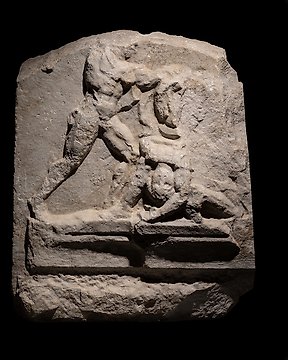
Ancient Greek Marble Metope from a temple with Heracles hero fighting Hippolyta. EX- SOTHEBY'S
No. 81632861

No. 81632861

Head of a young girl, Eros or wounded amazon
CULTURE: Hellenism, Greece
PERIOD: Late Period, 1st century B.C.
MATERIAL: Marble
DIMENSIONS: 18 cm high, wihtout stand.
PROVENANCE:
- Private collection J. P., Germany. Acquired in the 1970s.
CONSERVATION: Good general condition, with restoration on the nose. It presents remains of green incrustations on the back patina of the hair, produced, in the antiquity, by the contact of the marble with some bronze object.
Young head carved in marble in round bulk with the back roughly carved, which allows us to deduce that it would be attached to a scene background in relief, so that it would be contemplated from the left side of the composition. In fact, the face is worked in three-quarter view from the left, and the head is dramatically turned in the same direction. The features are delicate and soft, making it difficult to identify whether it is a young man or a woman. The hair is long and wavy, worked in thick sinuous locks, with a central topknot raised above the forehead; it falls in waves framing the right side of the face and is gathered on the opposite side, showing the left ear and thus reinforcing the impression of the turn of the head. The modeling of the face shows a clear heritage of the classical period, with well-defined volumes, straight nose and thick eyelids, but at the same time shows the naturalistic and expressive tendency of Hellenism in the general softness, the delicate movement of the hair and, especially, in the undulating outline of the brow, very different from the balanced classical arch, which adds drama to an otherwise serene and contemplative expression, typical of a divinity.
The type of hairstyle, with a small bun or braid on the head, appears mainly in the representations of Aphrodite and Eros (fig. 1), but the dramatic content of the face, its androgynous appearance and the turn of the head indicate that it could be the head of an Amazon fallen in battle or wounded (fig. 2), which can also wear this hairstyle and are a constant theme in the Greek art of classicism and Hellenism. From the relief of the amazonomachy that decorated the west pediment of the temple of Asclepius in Epidaurus comes a fallen amazon head that shows a position and expression close to those of the piece under study (fig. 3). There are also similarities with a famous model of a wounded amazon from the 5th century BC (fig. 4), although the difference in the serene face with a restrained expression, typical of the classical period, is notable.
There are also numerous known Greek images of adolescent Eros showing a similar expression, with dramatic content and serene nobility (fig. 5). The piece under study can be related compositionally to the famous model of Eros drawing the bow of Lysippus, a work dated to the mid-fourth century BC that was widely disseminated through copies and Hellenistic and Roman versions (fig. 6). The expression of the face, serious and with a half-open mouth, as well as the inclination of the head and the long hair also allow us to link the piece under study to the model of the Eros Centocelle (fig. 7), an original from the 4th century BC attributed to Praxiteles that was also reproduced in the following centuries by Greek and Roman artists.
PARALLELS:
Fig. 1 Head of Eros. Greece, Hellenistic period, 3rd-1st c. B.C. Marble. Ny Carlsberg Glyptotheque, Copenhagen, inv. 1781.
Fig. 2 Relief with dying Amazon. A.D. 2nd century Roman copy of a Hellenistic Greek original of the 2nd century B.C. Marble. Museo Archeologico Nazionale di Napoli (Italy), inv. 6012.
Fig. 3 Amazon fallen from the temple of Asclepius. Epidaurus, Greece, Late Classical period, 4th century B.C. Marble. National Archaeological Museum of Athens, inv. 4754.
Fig. 4 Wounded Amazon. Roman copy, 1st-2nd c. A.D. of a Greek original, 5th c. B.C. Marble. Metropolitan Museum, New York, inv. 32.11.4.
Fig. 5 Head of Eros. Roman copy of ca. 120-140 A.D. from a Greek original of ca. 300 B.C. Marble. British Museum, London, inv. 1879,0712.7.
Fig. 6 Eros drawing the bow. A.D. 2nd c. Roman copy of a Lysippus original of ca. 350-330 B.C. Marble. Musei Capitolini, Palazzo Nuovo, Rome, inv. S 410.
Fig. 7 Eros Centocelle or Farnese. Roman copy of the 2nd century AD of a Greek original of the 4th century BC attributed to Praxiteles. Marble. Museo Archeologico Nazionale di Napoli (Italy), inv. 6353.
BIBLIOGRAPHY:
- BIEBER, M. The Sculpture of the Hellenistic Age. Hacker Art Book. 1961.
- KOUSSER, R.M. Hellenistic and Roman Ideal Sculpture: The Allure of the Classical. Cambridge University Press. 2008.
- POLLITT, J. J. Art in the Hellenistic Age. Cambridge. 1986.
Notes:
- The piece includes authenticity certificate.
- The piece includes Spanish Export License.
- The seller guarantees that he acquired this piece according to all national and international laws related to the ownership of cultural property. Provenance statement seen by Catawiki.
#ExclusiveCabinetofCuriosities
How to buy on Catawiki
1. Discover something special
2. Place the top bid
3. Make a secure payment